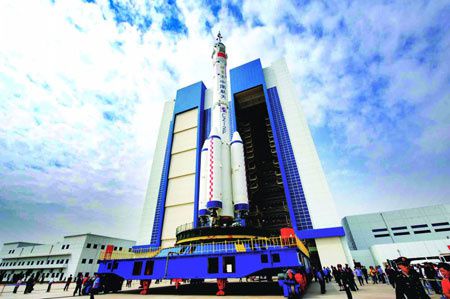October 1, 2015: Strategy Page
On September 20 2015 China successfully tested the latest version of its Long March satellite launcher; Long March 6 (LM 6). This version is optimized for putting multiple small satellites in orbit on the same mission and on short notice. The test launch put twenty small scientific satellites into orbit. LM 6 is a 103 ton liquid fueled rocket that can put a ton of payload into a 700 kilometers high orbit. LM 6 can operate from a standard satellite launch facility or from a TEL (transporter erector launcher) vehicle (which is basically a slightly larger trailer similar to those used for hauling tanks). LM 6 was also designed to be made ready for launch quickly (six days or so) giving it a military capability. That means if China has to get a surveillance or communications satellite in orbit quickly, LM 6 is the solution. China is also developing small surveillance and communications satellites for such emergencies.
China's main satellite launcher, the "Long March" rocket, is based on Russian designs, meaning it is simple, cheap and reliable. This has made China a major player in the satellite launching business. China competes on price. The U.S. Space Shuttle was retired because it was the most expensive way to get stuff into orbit. Satellites sent up via the Space Shuttle cost $25 million a ton. The Russians and Chinese will do it for under $10 million a ton. But insurance can more than double that cost if there have been a number of recent failures with Russian and Chinese boosters. This keeps more reliable American and European boosters in business. The Long March has a failure rate of about five percent, which was a little higher than twice the rate for the most used Russian launcher. The Space Shuttle failure rate was two percent, as were most Western satellite launchers.
The Long March 3 and 4 have been doing most of the Chinese commercial launches since the 1980s. Currently the largest Long March 3 model weighs over 400 tons and can put 12 tons in low earth orbit and 5.5 tons in a high one (geostationary transfer orbit). The Chinese took their time to perfect Long March, requiring 28 years to make the first fifty launches, and nine years for the next fifty. So far, Long March has carried out 202 successful launches.
While military satellites get more media attention, the real business of space, and where the Chinese put most of their efforts, is in commercial satellites. The Chinese have noted that since the 1980s space satellites have become big business. By 2012 there were about 1,000 active satellites in orbit, and nearly half of them were American. The number of satellites has been going down a bit since then because individual satellites last longer and can do more. It is expected that the number of satellites will now start to rise rapidly because of the popularity of mini-satellites (under 100 kg/220 pounds). Some of these mini-sats are much smaller (under ten kg) and still useful. In some cases dozens of mini-sats are put into orbit by one launcher.
About 75 percent of all satellites are non-military. Most of them are commercial, the rest government non-military birds. Since 2001 satellite industry revenues more than doubled, from $86 billion (in 2014 dollars) a year to over $200 billion now. The cost of the satellites is less than ten percent of annual satellite revenues. About four percent of the money comes from launching all those satellites and 36 percent of those launches are military. The U.S. has about a third of the launch business, mainly because of the requirement that U.S. classified satellites be launched by American rockets. About half the satellite launches (and two-thirds of the satellites) were for communications, which generates the most income (mostly for TV, followed by data). The U.S. remains the major manufacturer of commercial satellites, with over half of the market. China sees opportunity in all this and has come a long way in a short time to take advantage of it.
In 1957 the Russian Sputnik was the first satellite ever put in orbit. The U.S. followed in 1958. Since then, ten other nations have done the same. France launched its first satellite in 1965, Japan and China in 1970, Britain in 1971, and India in 1980. Israel launched its first satellite in 1988. Ukraine did so in 1995. Iran claims to have put a satellite in orbit recently, but there is no conclusive proof. North Korea put a dead (non-responsive) satellite up in December 2012 and South Korea followed with a successful launch of a very active satellite a month later.
Since 2010 China has launched about 20 satellites a year and by the end of the decade expect to have 200 satellites in orbit. This is about a fifth of the total and nearly half as many as the United States. At that point China expects to be launching 30 satellites a year and accounting for over a quarter of the worldwide launch capability. All this momentum has been the result of three decades of effort and an enormous spurt of activity since 2010. In the two decades after 1990 China carried out 30 commercial satellite launches, putting 36 satellites in orbit. Now China puts that many satellites up in 18 months.





























